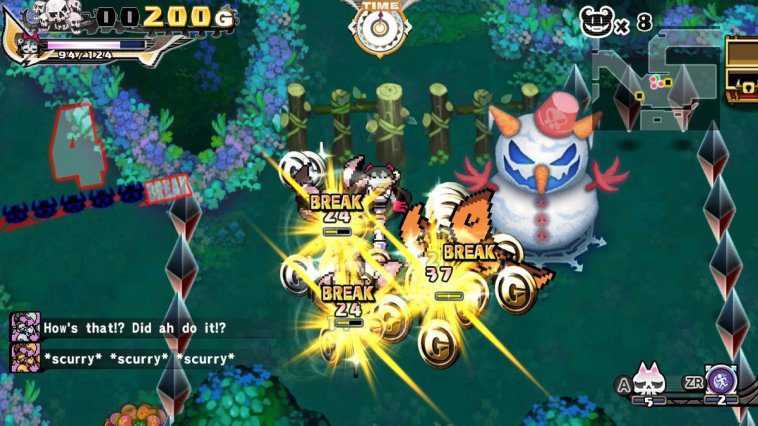Penny-Punching Princess opens by declaring that, in the age of capitalism, money is where real power comes from. This is a game about a princess who needs to accumulate wealth to get revenge on the Dragaloan Family, who sent her father into poverty and death with their harsh interest rates. It’s an intriguing, startling note for a cutesy beat-em-up game to open on. This isn’t a ‚message‘ game–don’t go in expecting a searing critique of capitalism, as it’s largely played for laughs–but this framing device immediately makes it clear that this brawler is going to be different. It might not be in the top-tier of its genre, but at the very least Penny-Punching Princess is unique.
The game is an isometric beat-em-up, in which fighting is your main form of interaction with the world. There are no puzzles to solve, and the level design is extremely simple, to the point of being universally uninteresting, designed just to funnel you between fights–the extent of permissive exploration is simply a matter of going left when your compass is telling you to go right. When a fight starts, the Princess (or Isabella, a zombified second playable character that you unlock a few hours in) can perform quick punches, use a stronger charge attack, or roll to safety. It’s not the deepest system, and your defensive options are limited.
Most fights involve a few waves of enemies, usually of increasing danger, and generally, there will be traps, like buzzsaws, giant rolling balls, and fields of poison, to avoid too. The Princess and Isabella play very differently, although most players will likely attach themselves to a favourite rather than swapping between them–I stopped using the Princess almost entirely after unlocking Isabella. Unfortunately, there’s not much variety in the game beyond this choice between the two. The arenas you fight in throw more and more traps at you as the difficulty ramps up towards the end of a chapter, but no specific encounter every really stands out.
When you beat enemies to a certain point, the word ‚break‘ appears over them, and if you rotate the right stick, coins will spill out of them. Coins are important during a fight, as they can be used to bribe both enemies and traps. Enemies vary in price depending on their power, but if you bribe an enemy not only will it disappear from the battlefield, but you’ll be able to summon it to fight for you. You can bribe traps too, meaning that they’ll stop hurting you and can be turned onto enemies. Traps are more cost-effective–they’re cheaper and tend to do a lot of damage–but using them properly also means that you need to lure your enemies into range. Leading a powerful enemy right into a trap and doing massive damage is extremely satisfying, even if most of the game’s boss fights come down to you leading a huge enemy from trap to trap. During hectic battles, it’s hard to know exactly what you’re about to bribe–the Princess can be more exact, but in the heat of the moment you’re more likely to just nab whatever is directly in front of you–which can get frustrating.

Every enemy and object you bribe gets added to your collection, which can be cashed in to build new armour and Zenigami Statues (which are effectively the currency used for stat upgrades). A piece of armour, for instance, might require you to have previously bribed five of a specific minor enemy, two of a stronger, more expensive enemy, and two buzzsaw traps. Each piece carries a price like this, and if you’re missing something the level select screen handily highlights four enemies and traps you’ll encounter in each individual level. Upgrading your armour is essential–occasionally you’ll hit enormous difficulty spikes and realise that you’re under-equipped, at which point you’ll typically need to jump back into earlier levels and grind to collect specific bribe targets (and search for treasure chests, many of which contain additional Zenigami statues).
The grind is rarely too severe if you’re being mindful and upgrading as you go, but the difficulty spikes can hit hard. It’s frustrating when you reach the end of a level only to find that the final boss is far too powerful for you to take on, and the checkpointing, which can be somewhat capricious, means that you’ll often have to redo easier fights just to reach the more difficult ones again. My frustration only occasionally boiled over to the point where I had to step away for a moment, but there was also rarely a real sense of reward for having beaten a difficult level, because you know the next level is just going to involve doing the same thing again.











All of this is presented without too much flourish. The sprite-based character designs are occasionally charming (Sebastian, a stag-beetle who acts as the princess‘ butler and appears in pre-and-post-level interstitials, is pretty funny), and the weird script plays up the game’s irreverence to good effect, but it’s difficult to really get invested in Penny-Punching Princess‘ cycle of punching and spending. While the game is moderately entertaining and has its moments it just doesn’t offer lasting satisfaction. Penny-Punching Princess doesn’t set its sights particularly high, and while it feels like it’s achieving what it intended, it’s hard not to wish there was a little more to it.
Website: LINK


